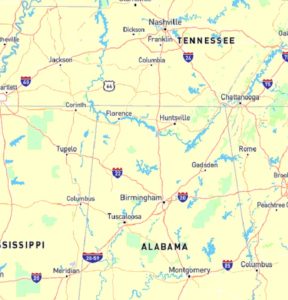Montgomery, Alabama vs Mobile, Alabama Population and Size Compared
Montgomery and Mobile are two prominent cities in Alabama, each with its unique historical significance, cultural attributes, and economic contributions to the state. While both cities have rich histories and vibrant communities, they differ in size, population, and community offerings. This article aims to provide an in-depth comparison of Montgomery and Mobile, exploring various aspects to help residents and visitors understand the nuances of these two cities.
Geographic Overview
Montgomery, Alabama
- Location: Montgomery, the capital city of Alabama, is situated in the central part of the state along the Alabama River. It serves as the county seat of Montgomery County.
- Area: Montgomery covers an area of approximately 161 square miles (416 km²), making it one of the larger cities in Alabama in terms of land area.
- Topography: The city features a mix of flatlands and rolling hills, with several parks and green spaces enhancing its natural beauty.
Mobile, Alabama
- Location: Mobile is located in the southwestern corner of Alabama, on the Gulf Coast. It serves as the county seat of Mobile County.
- Area: Mobile covers an area of approximately 139 square miles (361 km²), making it slightly smaller than Montgomery in terms of land area.
- Topography: Mobile’s geography is characterized by its coastal location, featuring waterways, wetlands, and lush vegetation, which provide scenic views and outdoor recreational opportunities.
Size Comparison
In terms of area, Montgomery is larger, covering approximately 161 square miles, compared to Mobile’s 139 square miles. This size difference allows Montgomery to accommodate a more extensive range of facilities, parks, and residential neighborhoods.
Population Statistics
Montgomery
- Population: According to the 2020 Census, Montgomery had a population of approximately 198,000 residents, making it one of the largest cities in Alabama.
- Demographics: Montgomery’s population is diverse, with a mix of ethnicities and cultures. The city has a rich African American heritage, which is reflected in its cultural events and historical landmarks.
Mobile
- Population: As of the 2020 Census, Mobile had a population of around 187,000 residents. The city has experienced fluctuations in population over the years but remains a significant urban center in Alabama.
- Demographics: Mobile also boasts a diverse population, with a mix of racial and ethnic groups. The city has a vibrant cultural scene influenced by its history as a port city and its proximity to the Gulf of Mexico.
Population Comparison
Montgomery has a slightly larger population, with approximately 198,000 residents, compared to Mobile’s 187,000. This population difference highlights Montgomery’s status as the state capital and its role as a central hub for government and education.
Historical Context
Montgomery
- Establishment: Montgomery was founded in 1819 and became the capital of Alabama in 1846. The city played a significant role in American history, particularly during the Civil Rights Movement.
- Historical Significance: Montgomery is known for its historical landmarks, including the Civil Rights Memorial, the Rosa Parks Museum, and the Dexter Avenue King Memorial Baptist Church, where Dr. Martin Luther King Jr. served as pastor.
Mobile
- Establishment: Mobile was established in 1702 and is one of the oldest cities in Alabama. It served as a French colonial capital before becoming a significant port city.
- Historical Significance: Mobile has a rich maritime history, with landmarks such as the Mobile Museum of Art and the USS Alabama Battleship Memorial Park, which attract tourists and history enthusiasts alike.
Educational Opportunities
Montgomery
- Schools: Montgomery is served by the Montgomery Public Schools system, which includes several elementary, middle, and high schools known for their academic programs and extracurricular activities.
- Higher Education: The city is home to several higher education institutions, including Auburn University at Montgomery and Alabama State University, which offer a range of undergraduate and graduate programs.
Mobile
- Schools: Mobile is served by the Mobile County Public Schools system, which includes a variety of public schools known for their academic achievements and student support services.
- Higher Education: Mobile hosts several colleges and universities, including University of Mobile, Spring Hill College, and Southern Alabama University, providing residents with diverse educational opportunities.
Economic Conditions
Montgomery
- Economy: Montgomery has a diverse economy, with major industries including government, healthcare, education, and manufacturing. The presence of state government offices and military installations significantly influences the local economy.
- Job Market: The job market in Montgomery offers various employment opportunities, particularly in education, healthcare, and public service sectors, making it an attractive location for job seekers.
Mobile
- Economy: Mobile’s economy is driven by its port activities, manufacturing, and tourism. The city is a significant hub for shipping and logistics due to its coastal location.
- Job Market: The job market in Mobile offers diverse employment options, particularly in shipping, manufacturing, and service industries, making it appealing for job seekers in these sectors.
Community Life and Culture
Montgomery
- Community Events: Montgomery is known for its vibrant cultural scene, hosting events like the Montgomery Jazz Festival, Alabama Book Festival, and First Fridays art walk, which celebrate local arts and culture.
- Parks and Recreation: The city features numerous parks, recreational facilities, and cultural institutions, including the Montgomery Museum of Fine Arts and the Alabama Shakespeare Festival, providing residents with opportunities for outdoor activities and cultural engagement.
Mobile
- Community Events: Mobile hosts various community events throughout the year, including the Mardi Gras celebrations, Mobile International Festival, and Azalea Trail Festival, which showcase the city’s rich cultural heritage.
- Parks and Recreation: Mobile has several parks, trails, and recreational facilities, offering residents numerous opportunities for outdoor activities and family-friendly events, such as the Mobile Botanical Gardens.
Transportation
Montgomery
- Transportation Network: Montgomery has a well-developed transportation infrastructure, including major highways like Interstate 85 and U.S. Route 231. Public transportation is provided by the Montgomery Area Transit System (MATS), offering bus services throughout the city and surrounding areas.
- Commute: Many residents commute within the city and to nearby areas for work, and the city’s layout allows for easy navigation and access to amenities.
Mobile
- Transportation Network: Mobile is served by several major highways, including Interstate 65 and Interstate 10, facilitating access to the broader Gulf Coast region. Public transportation options are available through the Mobile Bay Transit, offering bus services throughout the city.
- Commute: The city’s transportation infrastructure supports commuting to nearby urban centers, making it convenient for residents who work in Mobile or the surrounding areas.
Conclusion
In conclusion, Montgomery and Mobile are two distinct cities in Alabama, each offering unique characteristics and opportunities. Montgomery is known for its historical significance, larger size, and diverse economy, while Mobile is recognized for its coastal charm, maritime heritage, and vibrant cultural events.
Both cities provide a range of amenities, educational opportunities, and community engagement options for residents. Understanding their differences and similarities can help individuals make informed decisions about where to live, work, and explore.
Whether one is drawn to Montgomery’s rich history and governmental role or Mobile’s maritime culture and coastal lifestyle, both cities offer valuable experiences for those seeking to establish their lives in Alabama.





